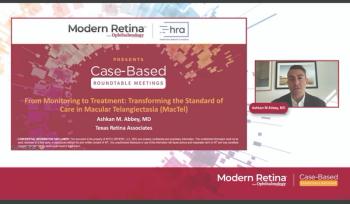
Intravenous prostaglandin E1 infusion for acute central retinal artery occlusion
The study finds that treatment resulted in a significant visual improvement.
EDITOR'S NOTE
Ophthalmology Times is pleased to recognize Brett Malbin, MD, resident, Kresge Eye Institute, Wayne State University, Detroit, is the first-place honoree of the second Ophthalmology Times Research Scholar Honoree Program. Dr. Malbin’s abstract is featured here. The Ophthalmology Times Research Scholar Honoree Program is dedicated to the education of retina fellows and residents by providing a unique opportunity for fellows/residents to share notable research and challenging cases with their peers and mentors. The program is supported by unrestricted grants from Regeneron Pharmaceuticals and Carl Zeiss Meditec Inc.
Purpose
In this abstract, we evaluate the efficacy of IV PGE1 infusion within the first 24 hours of acute central retinal artery occlusion (CRAO).
CRAO is a blockage in the main artery of the retina, often resulting in severe vison lost. CRAO tends to have a poor outcome, no matter what we do.
I’d like to say that we came up with this idea all by ourselves, but there was a 2013 study in Japan that looked at 10 eyes in 10 patients. The results were promising.
We took the data and became, to my knowledge, the first U.S. institution to publish the data on six eyes from six patients who were treated with IV prostaglandin infusion for acute central retinal artery occlusion.
Methods
The study included the retrospective analysis of six eyes from six patients. It included analysis of the best corrected visual acuity. (mean age: 69.33 years) with acute CRAO who were treated with twice-daily intravenous infusion of 40 μg PGE1.
The therapy continued until the patient no longer experienced visual acuity improvements for 24 hours.
RELATED:
Results
The average time to presentation was 8.33 hours, with a range from two to 12 hours.
The average age at presentation was 69.33 years old.
In the study, 66.67% of patients were African American, and 33.33% were Caucasian.
The BCVA logMAR at presentation was 2.73 and found to be 1.48 (p=0.025) at one-month follow up.
There was essentially no correlation between time to presentation and amount of visual recovery (R2=0.036). Six out of six eyes in the study showed improved visual acuity. We would like to expand the study to include more patients.
Conclusion
The study found that IV PGE1 infusion resulted in a significant visual improvement in patients presenting with acute CRAO.
Therapy at 40 μg BID was well tolerated and no patients experienced significant or mild side effects.
The study also found that six of six eyes demonstrated visual improvement compared to 16% of patients as previously described.1
In summary, CRAO can present in all ophthalmology settings ranging from private clinics to tertiary academic centers and to date there have been no studies which were able to show reproducible significant visual acuity recovery.
Our data suggest PGE1 IV infusion may represent a safe and effective treatment for CRAO resulting in statistically significant visual acuity recovery in patients.
This study is limited by its retrospective nature, and future randomly selected prospective studies can further look to determine the effectiveness of therapy.
RELATED:
Disclosures:
Brett Malbin, MDE: bmalbin@med.wayne.edu
Dr. Malbin has no financial disclosures to report.
Xihui Lin, MDE: xihui.lin@wayne.edu
Dr. Lin has no financial disclosures to report
References:
1. Hayreh S.S.: Ocular vascular occlusive disorders: natural history of visual outcome. Prog Retin Eye Res 2014; 41: pp. 1-25
Newsletter
Keep your retina practice on the forefront—subscribe for expert analysis and emerging trends in retinal disease management.












































